|
|
| Разместил (Author): |
SergUA6  |
| Авторские права |
© http://www.radioscanner.ru |
|
|
Текст
|
An output from discriminator and program processing.
FSK-2 module of the demodulator in SA.
Let’s consider some aspects of decoding of the various signals from a discriminator’s output once again. For instance, we are taking well known signal APCO-25, although all principles and practical approaches, which we will consider below work on any signals.
With introduction FSK-2 module of demodulation in SA, all can be easily checked and repeated. I come back to APCO-25 once again, for two reasons.
In the first: it was impossible to check up conclusions of the previous article, as there was no corresponding tool, now such tool exists and is available to everyone.
In the second: we will confirm the previous results and we will more deeply study the problem of discriminator’s output and decoding, because there are more problems than it seems. It is very well visible on example APCO-25, but once again I will underline, these are standard problems for any signal taken off from the discriminator. Besides, I want to show, that FSK-2 demodulator is intended, and created, not only for demodulation. :-)
Here is the record of almost ideal signal APCO-25 standard in IF kind. This record had been taken directly from the terminal. Better quality hardly can be received, probably only if to synthesize the signal directly
.
The phase detector realizes discriminator functions in SA. It possesses very high linearity and broadband response – almost an ideal discriminator.
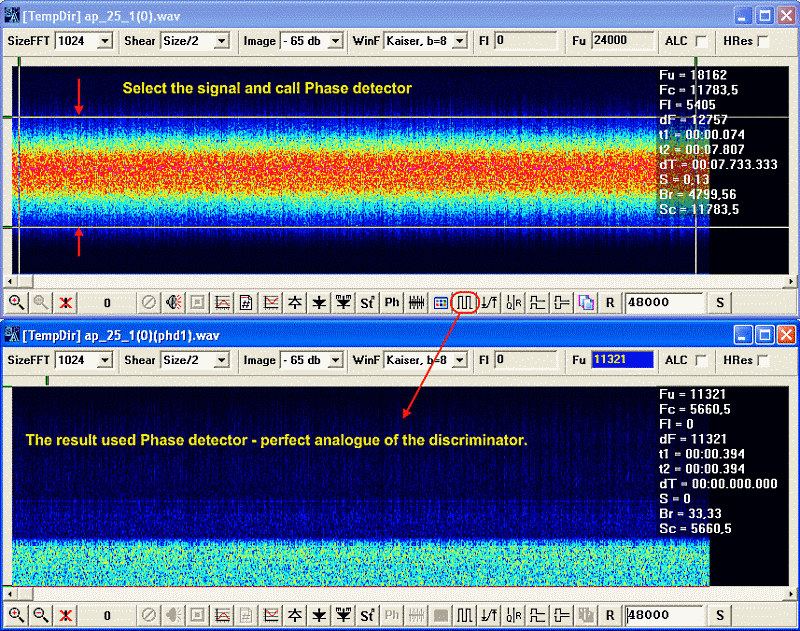
We are receiving clock frequency of manipulation, and we call signal’s form viewer, for scale setting or correction of displacement (shift) of the signal. FSK-2 demodulator module is also called from this module.
The measured value of clock frequency is automatically brought into all other modules, where it is used. If measurements are not done, then value Br is equal 33.33 Hz by default, and manual input in other modules is required.
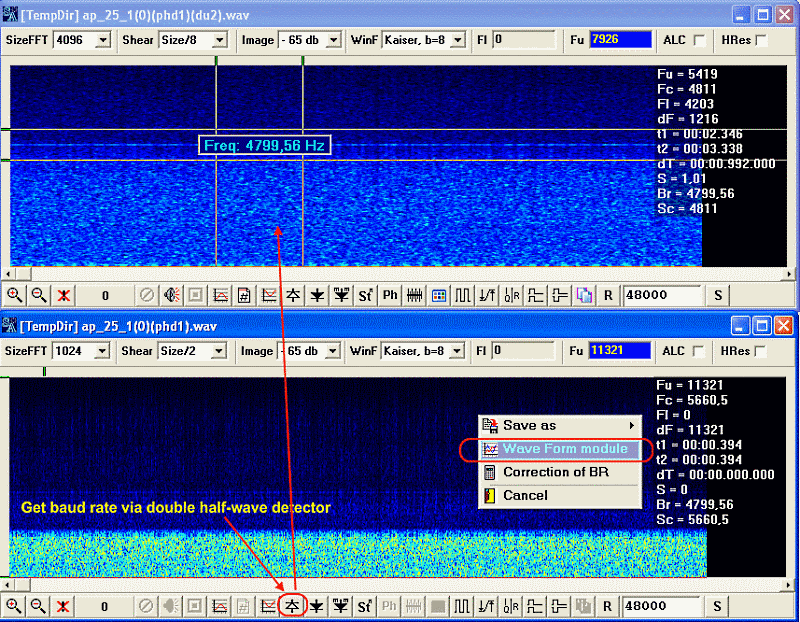
Preliminary scaling by vertical, and displacement of the signal concerning zero, are realized in the form’s viewer module, if it is needed. In our case, it is necessary to lift-up amplitude. Displacement (shift) concerning zero does not demand correction, because even if it does exist it is extremely small.
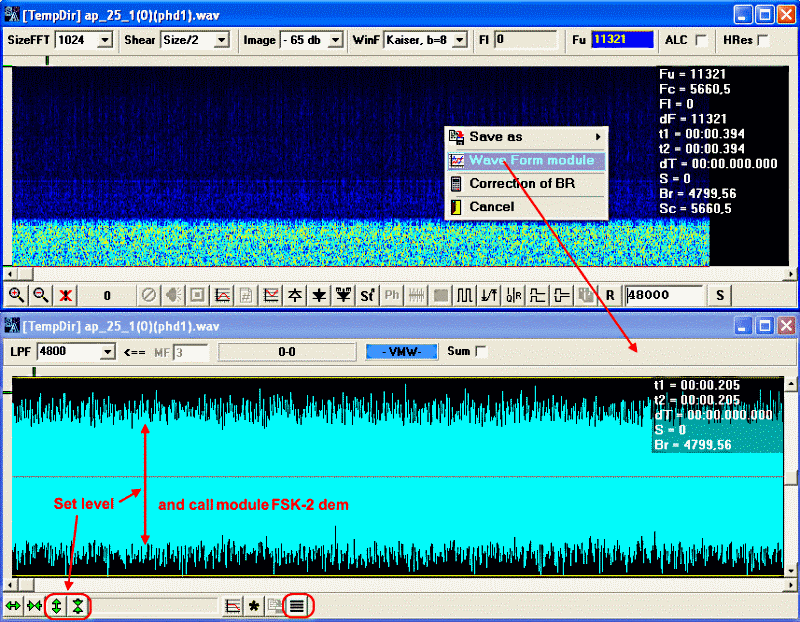
After necessary corrections, we are calling FSK-2 demodulator, where after setup of precise settings, we will receive an objective picture of allocation of levels of modulation C4FM, during the moments of exact clock synchronization.
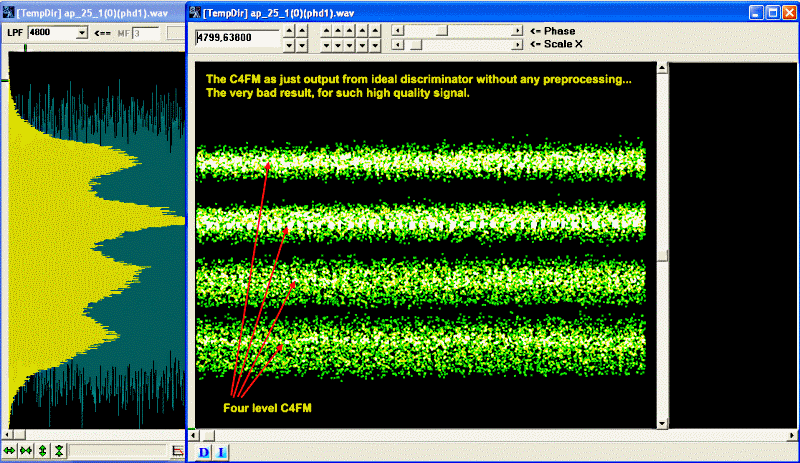
As it was noticed above, the signal has almost ideal quality. And despite that, it is possible to spend faultless decoding (as the levels are rather good and are completely divided/separated), after all we got very very bad result.
I focus attention on the bad result, only for this purpose to show, what even in such perfect conditions(as the signal has very high quality, and the phase detector possesses the highest linearity), simply only discriminator’s output, even from the ideal discriminator is a little suitable for practical use. Pre-processing, or better to say, coordinated filtration is required. Without this procedure, chances of qualitative program decoding are extremely not great, even on ideal signals.
Standard APCO-25 provides use RRC filter with alpha = 0.2
We will consider, usage of both the regulated filter, and SA. SA have two possibilities.
The first possibility - to use filters of selection/rejection of the basic working window, these filters have very high order and possess very good squareness.
The second possibility - to use filters, which are included in forms viewer. These filters possess lesser strict characteristic, and their repeated use can bring more optimum results.
I pay attention, here is we give a proof how, to define what is necessary for qualitative decoding, by using SA possibilities, and what is necessary to take into account if something is not as it should be.
As it will be shown below, it is necessary at least, to follow standards and recommendations of the manufacturer.
Four cycles of filtration in the module of forms viewer, the soft filter
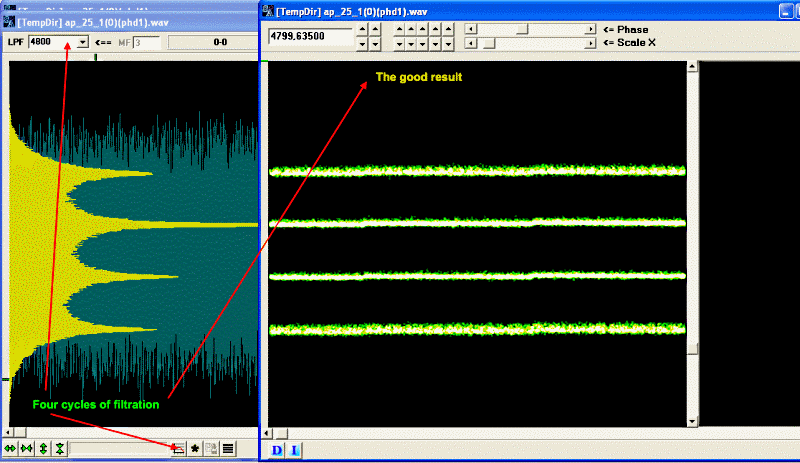
Cutting of all that is above the signal the strict rectangular filter of the basic working window.

Using regulated RRC filter we will surely build in this type of filters in the future.

It is well-visible, that applying of any filter only does make picture better. The best results turn out at completely coordinated filtration, but it demands an individual approach to the signal. In this case, we simply had luck.
Sub-optimum filtration by RRC filter, secure quite qualitative result by default, and favourably differs that it doesn't demand any tunings. Although, in practice, it can do not provide as much as possible achievable quality, because, finally, it doesn't compensate distortions in the channel.
We have received the same conclusions, as earlier. Pre-processing is necessary for sure at processing of the signal from the discriminator’s output, at least for APCO-25. As the minimum it should be RRC filter stipulated by the standard, as a maximum should be the system of an adaptive filtration, that is much more difficult in realization, but can provide as much as possible achievable quality of decoding.
There is one more problem, which it is necessary to remember and about which earlier we had not speak.
Above, we considered (and we made special emphasis on it), work of ideal сomponentы. We have the very qualitative signal and very qualitative discriminator. In practice, all is not so. Very narrow moment is the joint (meeting-point) of the physical discriminator with a physical sound card, through which decoding of the signals is usually realized.
An Example. The record from discriminator’s output. Before pre-processing, the quality of demodulation is estimated as an average, which is even closer to the bad quality. It is not possible to decode two top levels without errors.

Sub-optimal and optimal filtration with RRC filer are much better, and, in general guarantees decoding without errors. Optimal filtration is naturally better.

I want to pay attention to bursts (outbursts), to which the signal is subject to.

These outbursts, are entirely on conscience of the concrete user and user’s equipment. These outburst are not present in the signal.
The matter is, that the discriminator’s output means, generally, transfer of a constant component. When we are working in SA, it is guaranteed by default. SA doesn't bring any distortions in the signals, if it is not done for special.
In real physical devices, such guarantee doesn’t present. As a rule, inductive coupling with the sound card, or various untying chains and units(knots) are used. Blocking of the constant component deforms long impulses, and finally can fully destroy useful signal.
This is one of the reasons why I prefer I/Q or IF records to all rests. There are no guarantees of a qualitative signal transmission/record. It can depends on the sound card, the variants, when transfer of the constant component occurs, but the sound card can't process it correctly, are not expected.
Such distortions are easily modelled in SA. It is possible to determinate admissible level of blocking. But I will be limited simply by examples, an interested persons can investigate this moment independently.
Let’s check it on the signal after optimum filtration.

Once again, we don't distort the signal purposely, we model an absolutely real problem, which is present at the records of overwhelming majority of users, while they are simply do not know/suspect about. :)
UPF with cutoff ~8 Hz

UPF with cutoff ~30 Hz

It is visible that blocking of the constant component brings characteristic and negative distortions in the signal, to compensate which is extremely inconveniently, if it is even possibly at all.
Thus, in this article, I wanted to show, that SA allows to solve wide spectrum of problems, and basically it is accessible to everyone, and there is nothing difficult in it.
For the qualitative processing of the signals from the discriminator’s output, such as APCO-25, it is necessary to pay very serious attention to pre-processing, the suboptimum filtration is surely necessary. An ideal variant, adaptive watching filters.
Also, it is necessary to pay close attention to transfer of the constant component in the (into) demodulator/decoder, at least for the most of signals on VHF, it is very actual.
Especially it concerns constructions of different repeaters and re-translators. As the kind of some APCO-25 signals/records in I/Q or IF format, obviously says, that the part of distortions is connected with losses of the constant component at re-receptions, that sharply narrows the zone of confident connection, and extremely negatively influences on the quality as a whole.
Good Luck~
|
|
|
|
Добавлять комментарии могут только зарегистрированные, активировавшие регистрацию и не ограниченные в доступе участники сайта!
|
| Файл создан: 15 Sep 2010 00:41, посл. исправление: 18 Sep 2010 14:30 |
|

